- Quick Read
- Deep Read ( 6 Min. )
In Today’s Issue
- Historic Israeli desire to ‘go it alone’ is tested by Gaza and Iran
- Today’s news briefs
- What to know as Trump trial moves toward pivotal witness
- Xi Jinping tries to rescue China’s relationship with Europe
- Sudan war’s rape survivors flout taboos to help each other recover
- Audubon’s bird paintings owe debt to classical European art
Monitor Daily Podcast
- Follow us:
- Apple Podcasts
- Spotify
- RSS Feed
- Download
TODAY’S INTRO
What lies at the heart of political progress
Political leadership means also knowing how to follow. At least how to listen.
Some of that is about staying in power. It’s also how the actual aspirations of a people – sometimes more overlapping than not – help shape a nation.
Today, Howard LaFranchi leads our Daily with a look at the hands on the dials of political calibration in Israel. The Netanyahu government now wrestles with what comes next in Gaza. Its actions there have yielded increased international isolation and rising domestic dissent. Can it reverse some of that?
As many diplomats would note, it might start with close and careful listening.
Share this article
Link copied.

Help fund Monitor journalism for $11/ month
Already a subscriber? Login

Monitor journalism changes lives because we open that too-small box that most people think they live in. We believe news can and should expand a sense of identity and possibility beyond narrow conventional expectations.
Our work isn't possible without your support.
Historic Israeli desire to ‘go it alone’ is tested by Gaza and Iran
Israel is facing historic challenges over its instinct to act alone in war. One comes from a rift with its U.S. ally over Gaza. Another comes from the demonstrated benefits of regional cooperation and integration.

As the world grows increasingly critical of the war in Gaza, Israel finds itself facing a pivotal and indeed historic choice.
Does it hold fast to a fundamental, go-it-alone tenet of its founding national security doctrine, or do shifting geopolitical dynamics call for a more cooperative and international security strategy?
Israel is sending mixed signals over which path it will take. Prime Minister Benjamin Netanyahu continues to use the “we will go it alone if we must” rhetoric. At the same time, the promised assault on Rafah has so far been limited.
Israel was already shifting away from its historical stance before the Hamas attack and war in Gaza, some analysts say, pointing to deepening cooperation with a growing number of Arab neighbors. The question now, they add, will be how far and for how long Israel’s chosen path in Gaza sets back or even reverses Israel’s opening.
“This is an important moment that will have a very significant impact on what was already a process of more integration into the region and more opening up to international cooperation,” says Nimrod Goren, a senior fellow at the Middle East Institute. “There is a sense that Israel’s global standing is very much on the line.”
Historic Israeli desire to ‘go it alone’ is tested by Gaza and Iran
As the world grows increasingly critical of the war in Gaza and pressure builds for a permanent cease-fire, Israel finds itself torn between two inclinations: cooperate with the international community that rallied to its side after Hamas’ attack in October, and Iran’s in April, or go it alone.
And as negotiations over a potential cease-fire and hostage release deal continue, and even as Israel ratchets up bombardments and other operations in the southern Gaza city of Rafah, Israel is sending mixed signals over which path it will take.
Prime Minister Benjamin Netanyahu continued this week to use a blustery “we will go it alone if we must” rhetoric publicly. At the same time, the promised assault on Rafah has so far been limited and targeted – although a massing of Israeli troops outside the city Thursday suggested accelerating preparations for a ground assault.
The choice facing Israel is pivotal and indeed historic in its ramifications.
Does it hold fast to a fundamental tenet of its founding national security doctrine, that it depends solely on itself and fights its wars alone? Or do shifting geopolitical dynamics – and especially Israel’s desire to strengthen regional ties in the face of confrontation with Iran and its proxies – call for a more cooperative and international security strategy?
Israel was already shifting away from a go-it-alone stance before the Hamas attack and Gaza war, some analysts say, pointing to deepening cooperation with a growing number of Arab neighbors. The question now, they add, will be how far and for how long Israel’s chosen path in Gaza sets back or even reverses Israel’s opening.
“This is an important moment that will have a very significant impact on what was already a process of more integration into the region and more opening up to international cooperation,” says Nimrod Goren, senior fellow for Israeli affairs at the Middle East Institute in Washington.
“I don’t think we’ll be going back to the notion of ‘Israel alone’ that Netanyahu is preaching now,” he adds, “but there is a sense that Israel’s global standing is very much on the line and will face the consequences of what happens” both in Rafah and with the cease-fire negotiations.

For some military analysts, the so-far limited Rafah operation should be seen as pressure on Hamas to accept a mutually palatable cease-fire deal. But others see it as a nod to U.S. President Joe Biden, who has stated his strong disapproval of Mr. Netanyahu’s promised full ground invasion of Rafah, where more than 1 million displaced Palestinians are sheltering.
“Netanyahu may very well be making these moves signaling Israel’s going into Rafah to keep the pressure on” the cease-fire and hostage-deal negotiations, says Benjamin Friedman, policy director and a Middle East expert at Defense Priorities, a realist foreign policy think tank in Washington.
Biden delays shipment of bombs
The Biden administration put some meat on the bones of its Rafah assault objections by last week pausing an arms shipment to Israel, a first for a U.S. president who has long portrayed his support for Israel as complete and unshakable. Mr. Biden ordered a halt to a shipment of 3,500 large bombs over concerns, according to administration officials, that they would be used to strike Rafah.
The president went a step further Wednesday, saying the United States is “not going to supply the weapons and the artillery shells” for an invasion. “They’re not going to get our support if, in fact, they’re going into these population centers,” he said in a CNN interview aired Wednesday evening.
International objections to an assault on Rafah were further underscored by the French Foreign Ministry earlier this week, when it revealed in a statement that President Emmanuel Macron warned Mr. Netanyahu in a phone conversation Sunday that Israel would be committing a war crime under international law if it forcibly displaces civilians from Rafah.
“What we are seeing publicly now is a fight between President Biden and Netanyahu over what the priorities are in the war, with Netanyahu trying to play the Rafah card especially for domestic political reasons,” says Mr. Goren, who is based in Israel. “But there is a gap between public statements and what is happening on the ground,” he adds, “and if you look closely, you see that Israel has up to now been taking into account U.S. and Egyptian and others’ demands.”
The choice Israel faces has been salient at least since March, when the U.S. signaled its growing frustration by declining to use its veto in the United Nations Security Council to stop a cease-fire resolution – an expression of global condemnation that until then had been a red line for the Biden administration.
Common cause against Iran
But then in April, the U.S. assembled and led a coalition of countries – including Jordan, Egypt, and even Saudi Arabia – to help defend Israel against an onslaught of Iranian drones and missiles dispatched by Tehran as retaliation for Israel’s bombing of an Iranian compound in Syria.
At the time, some U.S. officials and Middle East analysts expressed hope Israel would value having international partners – particularly Sunni Arab neighbors that share common cause against Iran – and alter its historical approach as a friendless Jewish state willing to act alone in a hostile world.
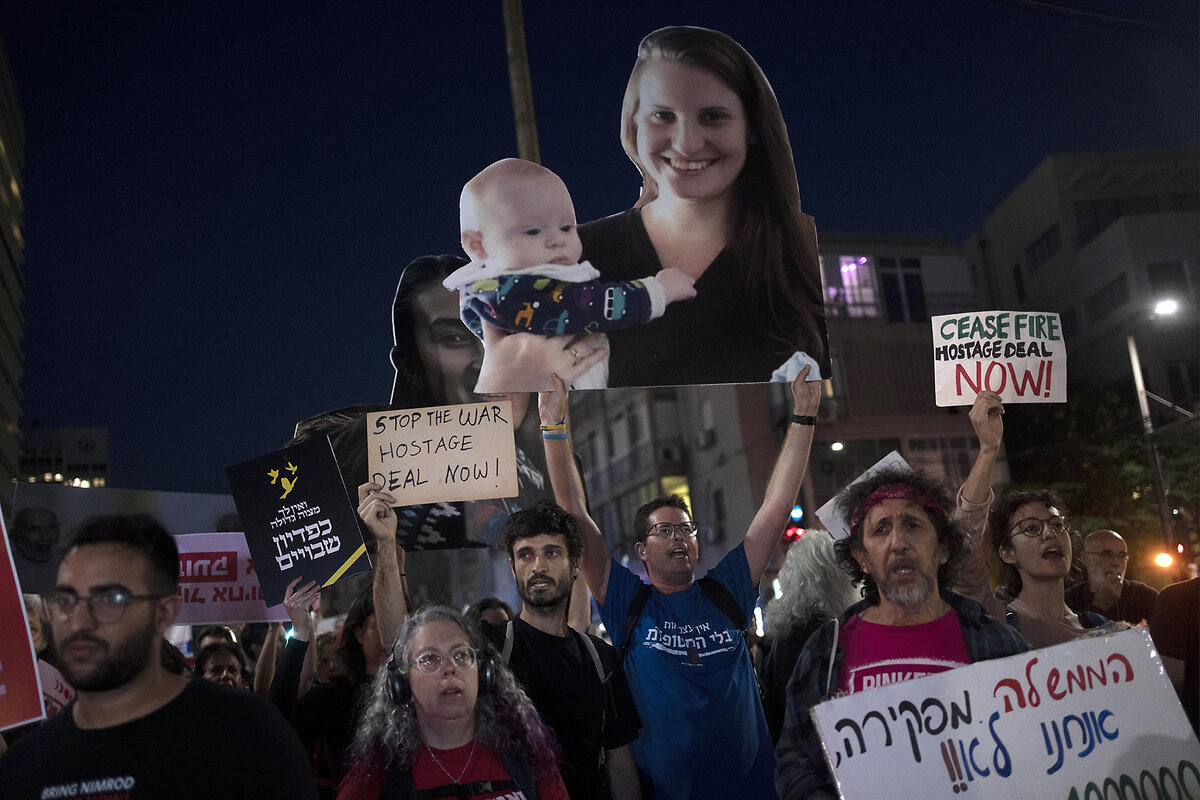
Some have even posited that the war in Gaza presents Israel and in particular Mr. Netanyahu with an opportunity to end the conflict and fashion a postwar era that results in greater security for Israel and stronger relations with its Arab neighbors, including Palestinians and Saudi Arabia.
But shortly after the U.S.-led coalition’s successful response to Iran’s first-ever direct assault on Israeli territory, Mr. Netanyahu reverted to a more traditional position of Israeli self-defense unfettered by international entanglements.
“If we need to stand alone, we will stand alone,” Mr. Netanyahu said Sunday before a group of survivors of the Holocaust. “If we do not defend ourselves,” he added, “nobody will defend us.”
Such rhetoric is directed at a particular segment of the Israeli public and at Mr. Netanyahu’s own right-wing coalition government, some experts say.
“Netanyahu likes the optics of defying the Biden administration and saying, ‘We Israelis can defend ourselves and do things on our own,’” says Mr. Friedman. “He knows that if he says publicly, ‘I can’t go into Rafah because of Biden and all the other international pressures,’ he risks losing his coalition, and as a result losing power.”
Eye on Israeli elections
As for the path ahead, Mr. Friedman says he sees Israel staying the course toward greater regional cooperation that it was already on before the war. Where Israel’s execution of the war will have greater impact, he adds, is on Israel’s relations with Europeans and other “liberal Western countries” that place a priority on issues like human rights and treatment of the Palestinians.
Moreover, eventual Israeli elections will play a key role in determining how Israel moves forward in the war’s aftermath, experts say.
For Mr. Friedman, Mr. Netanyahu may be playing for time to see how the U.S. presidential election goes in November. The Israeli leader “may very well be thinking that if Trump wins, he can get everything he wants in terms of the region and relations with the Saudis” without any of the concessions Mr. Biden is seeking on Palestinian governance and an eventual Palestinian state.
Mr. Goren foresees the broad question of Israel’s relations with the world taking a front-and-center role in any campaign before the next set of elections, whenever they occur.
“The war and its impact on Israel’s global standing are viewed one way by the more international elements, the tech companies and the universities and professors, and another way by Netanyahu’s base and others who basically see a hostile world,” he says. “The debate between those two sides will be played and become more important before the next Israeli elections.”

Today’s news briefs
• Russia hits Ukraine’s grid: Missiles and drones strike nearly a dozen energy infrastructure facilities, causing serious damage at three Soviet-era thermal power plants and blackouts in multiple regions, officials say. Ukraine says it shot down 39 of 55 missiles and 20 of 21 attack drones.
• Gaza protests spread to Europe: Britain’s prime minister calls for an end to “antisemitic abuse” at universities in the United Kingdom. German police break up a protest by pro-Palestinian activists at Berlin’s Free University. Students have held protests in Finland, Denmark, Italy, Spain, France, and the Netherlands.
• Aid heads to Gaza pier: Cyprus’ foreign minister says a shipment of humanitarian aid has left a port in Cyprus and is on its way to the U.S-built pier in Gaza, the first delivery to the newly built ramp.
• Speaker survives ouster bid: Republican Rep. Marjorie Taylor Greene fails to oust House Speaker Mike Johnson. Her long-shot effort was resoundingly rejected by Democrats and Republicans.
• Rule change in Haiti? Instead of a single president, four veteran politicians will take turns leading a transitional council, say two members who were not authorized to describe the as-yet unannounced changes.

What to know as Trump trial moves toward pivotal witness
For all the drama of her testimony at Donald Trump’s hush money trial, Stormy Daniels is something of a preliminary witness. The most legally important moment may be yet to come.
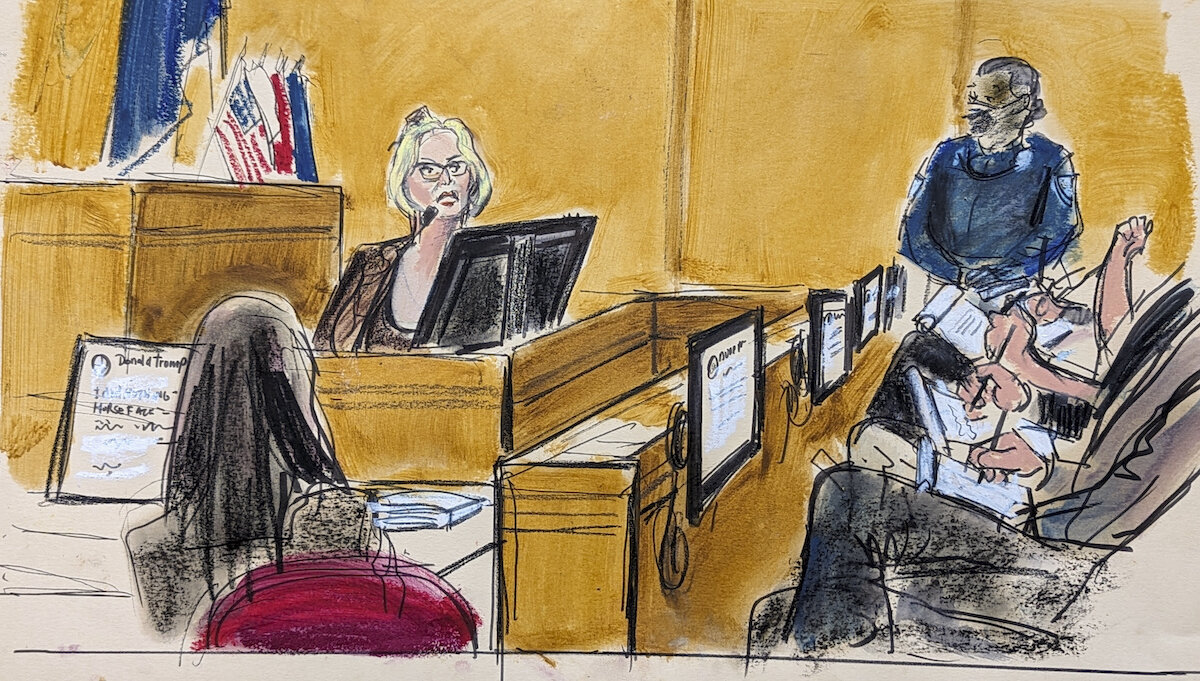
- Quick Read
- Deep Read ( 6 Min. )
This week porn star Stormy Daniels provided explosive testimony in former U.S. President Donald Trump’s hush money trial, describing her alleged sexual encounter with Mr. Trump in 2006 – something the former president has publicly denied ever occurred.
But the most confrontational and legally important moment of the trial is likely still to come: the appearance of former Trump personal attorney and fixer Michael Cohen on the stand.
Mr. Cohen almost certainly will be the only witness to testify that Mr. Trump personally told him to make a payoff to keep Ms. Daniels quiet – and that the reason for the payment was to hide her story from voters. His narrative links all the elements of the prosecution’s case together.
He also can be an abrasive and difficult witness, with recent convictions on campaign finance abuses, tax evasion, and other charges. The legal struggle to frame his story for the jury could well determine the trial’s outcome.
“I submit to you that he cannot be trusted,” Trump lawyer Todd Blanche said of Mr. Cohen in the defense’s opening statement.
“You will need to keep an open mind” about Mr. Cohen, said prosecutor Matthew Colangelo. “Keep in mind all the evidence that corroborates Mr. Cohen’s testimony.”
What to know as Trump trial moves toward pivotal witness
This week porn star Stormy Daniels provided some of the most explosive testimony yet in former President Donald Trump’s hush money trial in a Manhattan courtroom.
Under oath, and in front of a jury, Ms. Daniels described in vivid detail her alleged sexual encounter with Mr. Trump during a celebrity golf tournament in Lake Tahoe, Nevada, in 2006 – something the former president has publicly denied ever occurred.
But for all the drama of her testimony and cross-examination by Trump attorneys, Ms. Daniels was something of a preliminary witness.
The trial is now barreling toward what may be the most confrontational and legally important moment yet: the appearance of former Trump personal attorney and fixer Michael Cohen on the stand.
Mr. Cohen almost certainly will be the only witness to testify that Mr. Trump personally told him to make a payoff to keep Ms. Daniels quiet – and that the reason for the payment was to hide her story from voters. His narrative links all the elements of the prosecution’s case together.
But Mr. Cohen – as others have already testified – can be an abrasive and difficult witness. He has a recent criminal past, including convictions on campaign finance abuses, tax evasion, and other charges.
He is both crucial to the prosecution and a target for the defense. The legal struggle to define him and frame his story for the jury could well determine the trial’s outcome.
“I submit to you that he cannot be trusted,” Trump lawyer Todd Blanche said of Mr. Cohen in the defense’s opening statement for the trial.
“You will need to keep an open mind” about Mr. Cohen, said prosecutor Matthew Colangelo in his opening. “Keep in mind all the evidence that corroborates Mr. Cohen’s testimony.”
What did Stormy Daniels say?
Over two days of testimony, Ms. Daniels talked about her childhood and love of horses. In high school, she was editor of the yearbook and hoped to be a veterinarian. But she discovered that stripping paid more than shoveling manure, and veered into acting in explicit movies, and then into producing and directing adult entertainment.
She was chatty, even funny. She said that after Mr. Trump had invited her to dinner at the Tahoe tournament, her publicist told her to go, adding, “what could possibly go wrong?” At that, the trial overflow audience room burst into laughter.
Her descriptions were also detailed. She remembered that when she used the bathroom at Mr. Trump’s hotel suite, the shampoo in his toilet kit was not just Pert, but Pert Plus.
Her speech might actually have been too loquacious. The defense objected to prurient details as prejudicial, and Judge Juan Merchan scolded her at least twice, telling her to stick to the questions asked and not meander down verbal alleyways.
On cross-examination, Trump attorney Susan Necheles chipped away at some of her story, trying to portray her as a greedy fabulist. Ms. Daniels bristled at the charges, and their exchanges turned tense. When Ms. Necheles charged that the porn star was “looking to extort money” during negotiations over her hush money payment in 2016, Ms. Daniels had had enough. She loudly responded: “False!”
On Thursday morning Ms. Necheles continued along the same lines in a fiery wrap-up of her questioning. At one point, she directly accused Ms. Daniels of lying just to make money. “You made all this up, right?” the Trump attorney asked.
“No,” Ms. Daniels replied.

Was Stormy Daniels’ story important?
Ms. Daniels’ allegations about her affair with Mr. Trump – which, again, he has denied – are the animating force behind the first criminal trial of a former president in U.S. history. In that sense, they are very important.
In a legal context, her words gave the jury a sense of why Mr. Trump might have been motivated to strike a deal to keep her silent, and of the stakes for him of not doing so only weeks prior to the 2016 presidential vote. Plus, she testified to the effectiveness of the alleged cover-up, saying that she would have spoken out had Mr. Cohen not paid her $130,000 before the election.
But it is not illegal to pay hush money per se, or to cheat on one’s wife. Mr. Trump instead is being charged with falsifying business records to achieve a criminal end. In that sense, the more important witness, or witnesses, was the documents described in Monday’s testimony by Jeffrey McConney, the Trump Organization’s longtime controller.
Perhaps the most important of these were People’s Exhibits Nos. 35 and 36. These were a sheet of notebook paper and a bank document that contained contemporaneous, handwritten notes from Mr. McConney and Chief Financial Officer Allen Weisselberg that detailed monthly payments to Michael Cohen.
“Yep, it’s the one with my chicken scratch on a Trump pad, yes,” said Mr. McConney cheerfully when identifying one of the papers, according to the trial transcript.
The notes said that Mr. Cohen would be paid back $130,000 – the amount of the hush money, though that’s not directly noted on the papers – plus another $50,000 expenditure he had made on behalf of the organization. On top of that, he would get a $60,000 bonus, and the whole thing would be doubled to account for taxes. That worked out to about $35,000 a month.
The notes said nothing about the sum being a payment for legal services, as they were described in Trump Organization books.
Asked by prosecutors if he had ever seen another expense reimbursement doubled to account for taxes, Mr. McConney said, “No.” He added that he had never seen the legal retainer the payments were allegedly fulfilling.
Why is Michael Cohen’s testimony key?
The one very crucial thing prosecutors have yet to establish is that Mr. Trump knew about the alleged hush money scheme and directed it. That is what they hope Mr. Cohen will establish in the eyes of the jury.
To this point, the prosecution case has focused on piling up circumstantial evidence that bolsters what they expect Mr. Cohen to say. On Tuesday, for instance, prosecutors called Penguin Random House executive Sally Franklin to the witness stand. She read excerpts from some of Mr. Trump’s management books in which he described the importance of being a detail-oriented, hands-on executive.
“I always sign my checks, so I know where my money’s going. In the same spirit, I also always try to read my bills to make sure I’m not being over-charged,” read one.
The message there, according to the prosecution, is that Mr. Trump had to know about the $35,000 a month he was paying Mr. Cohen, much of it with checks he personally signed in the White House.
The checks reached Mr. Trump outside the normal flow of White House paper. The Trump Organization sent them to the homes of two of the then-president’s personal White House aides, who then delivered them to the Oval Office for a signature, per Thursday’s testimony.
Mr. Cohen, however, promises to be a witness who could be a challenge for the prosecution as well as defense. He has pointedly and abrasively attacked Mr. Trump on social media. He has made no secret of his desire to avenge himself for the wrongs he believes the former president has done him in the past. During cross-examination, the defense is sure to challenge him as a convicted perjurer. Why should his words now be believed?
The prosecution has been secretive about the order and timing of its witnesses. Mr. Cohen could appear as soon as Friday – or days later. Prosecutors have said they are more than halfway through their witness list.
When he does testify, the tension in the courtroom will be the highest the trial is likely to experience – unless Mr. Trump, against the almost certain advice of his lawyers, decides that in the end he needs to testify for his own defense.
Editor’s note: This story was updated to include witness testimony on Thursday, May 9.

Patterns
Xi Jinping tries to rescue China’s relationship with Europe
Facing trade battles with Washington, Chinese leader Xi Jinping had hoped for a friendlier relationship with Europe. China’s subsidies for electric vehicle exports and its support for Russia’s Ukraine war have dashed those aspirations.
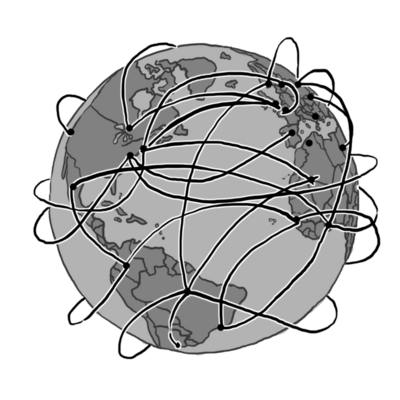
- Quick Read
- Deep Read ( 4 Min. )
When Chinese leader Xi Jinping last visited France, the sun was shining, Beijing was about to sign a free trade deal with the European Union, and French President Emmanuel Macron was trumpeting his hopes of making Europe less dependent on the United States.
But that was five years ago.
When Mr. Xi came to Paris this week, he was on a damage limitation exercise; Beijing’s stock in Europe, both among the public and government officials, has slumped.
That is largely because China is helping Russia wage its war on Ukraine. At the same time, the EU has put the free trade deal on ice over human rights concerns. And Brussels is taking initial steps toward imposing sanctions on Chinese electric vehicle exports, because of the government subsidies that Beijing is pouring into that business.
That poses a worrying prospect for China’s slowing, export-led economy: a two-front tariff war with the United States and the European Union.
Mr. Xi will hope to be able to ward off that outcome, and he has a chance to console himself at the end of the week when he visits two more reliable European friends – Serbia and Hungary, both of which support not only Beijing, but Moscow, too.
Xi Jinping tries to rescue China’s relationship with Europe

The visual contrast was striking: Spring sunshine bathed Paris when Chinese leader Xi Jinping last visited Europe five years ago. This week, he touched down for summit talks with President Emmanuel Macron under a cloak of gray cloud and drizzle.
But it’s the change in Europe’s political weather that will most concern China.
For years, amid its escalating trade battles with the United States, Beijing has been able to count on its other key Western trading partner, the 27-nation European Union, to steer clear of the superpower storm and keep economic relations on an even keel.
No longer.
A series of major jolts – the supply-chain effects of the pandemic, China’s repression of Uyghur Muslims, its crackdown in Hong Kong, and above all its support for Russia’s invasion of Ukraine – has hardened European attitudes toward Beijing among both the public and officials.
And a major new trade grievance, high on America’s agenda, too, is further straining ties: the huge volume of China’s state-subsidized exports of “future economy” products, including solar panels and electric vehicles.
With European producers finding it hard to compete, the EU is considering punitive tariffs.
And that has raised a deeply worrying prospect for China’s slowing, export-led economy: a two-front tariff war with both the United States and the European Union.
Mr. Xi will still hope to head that off.
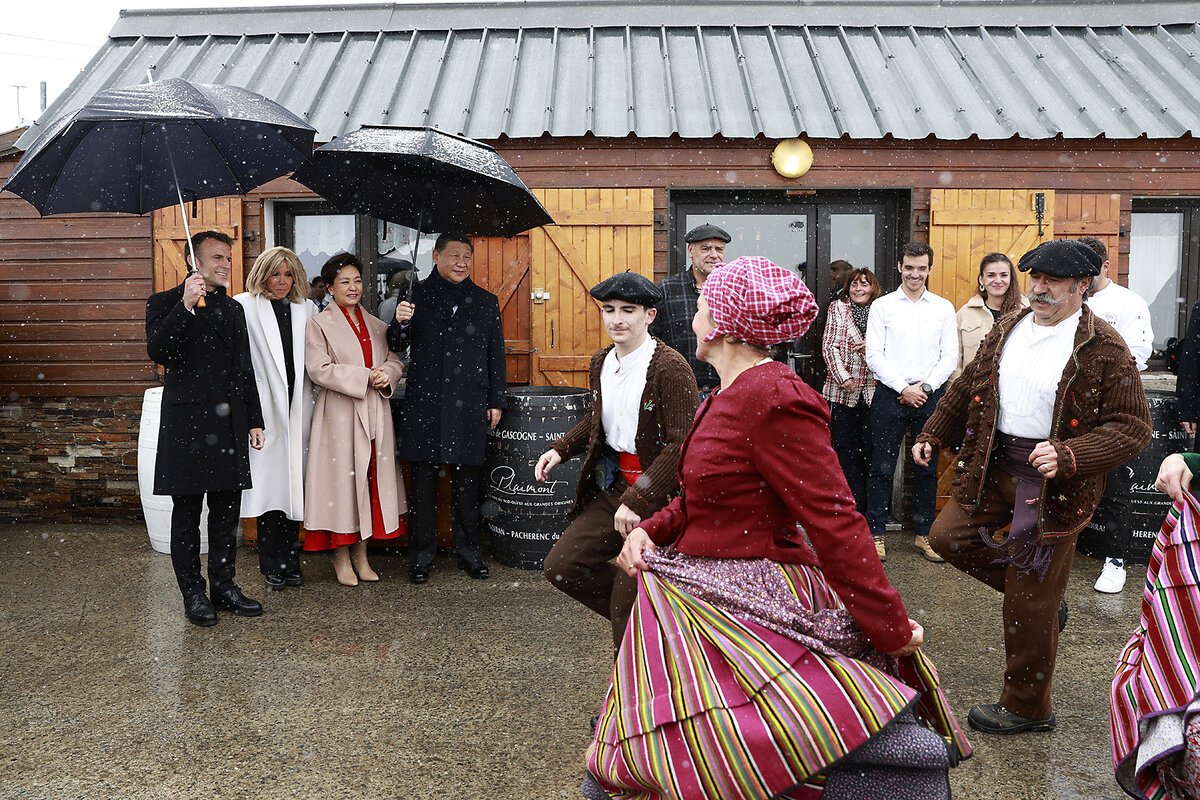
The world’s second-largest economy has ample tools with which to retaliate, and a range of European industries would be vulnerable to such retaliation. Among them is the most important industry in the EU’s largest economy: Germany’s automobile sector.
An unmistakable chill has descended over China’s relations with Europe, and the political weather forecast does not look promising.
Mr. Xi began his European tour by calling on Mr. Macron, the West European leader with whom he has built up his strongest personal relationship. Mr. Macron has been an outspoken advocate of greater European “sovereignty” from Washington.
Still, he was also a prime mover behind the EU’s recent decision to open an investigation into – and potentially to sanction – China’s EV exports to Europe.
And Mr. Xi’s itinerary once he left France on Tuesday underscored the shrinking number of true friends he now has in Europe. He visited two East European countries: Hungary and Serbia. Both are expanding economic ties to Beijing. Politically, both support not just China, but Russia, too.
Five years ago, the atmosphere surrounding Mr. Xi’s European trip could not have been more different.
Yes, Europe shared many of the concerns that had prompted U.S. President Donald Trump to unsheathe the tariff sword and seek to reshape trade with China. Beijing’s limits to market access, its encroachment on intellectual property rights, its enormous state subsidies, and its export-heavy trade balance with the West – all angered Brussels as much as Washington.
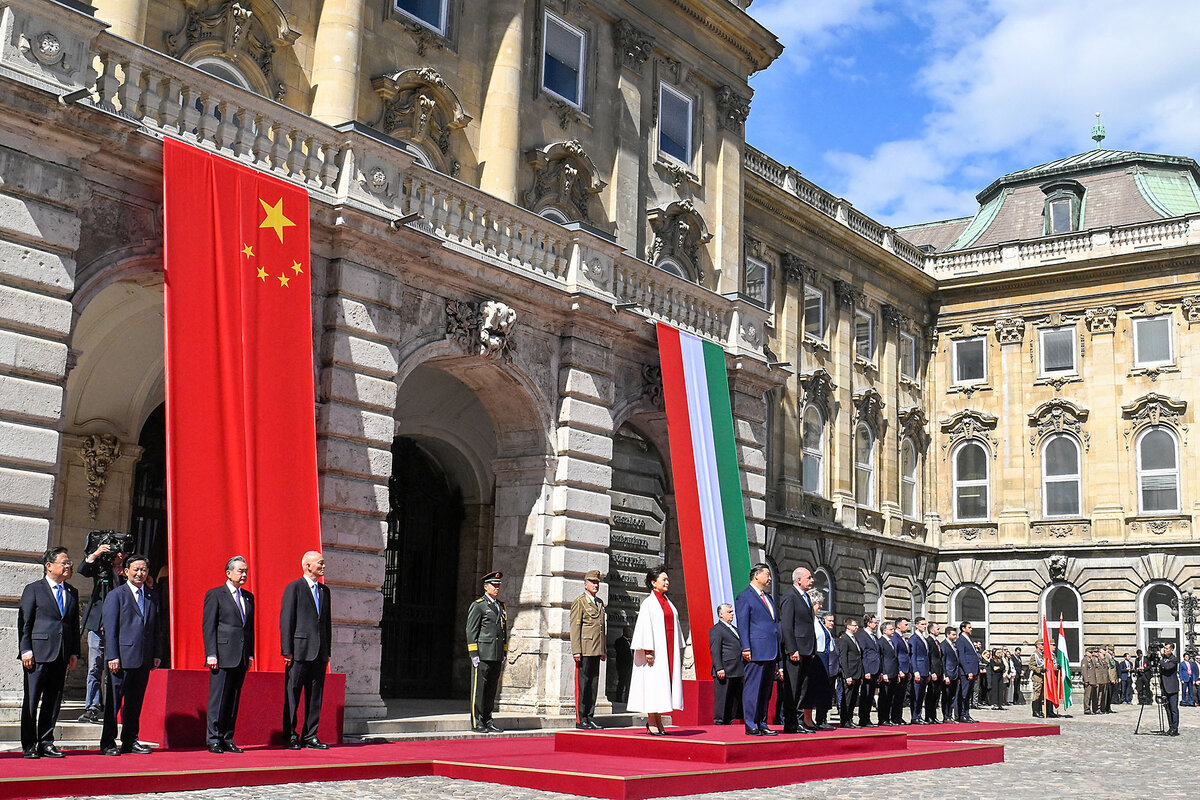
But the EU still sought a negotiated resolution. It hugely valued its relationship with China, and wanted no part of the Trump-Xi standoff.
After leaving France five years ago, Mr. Xi traveled to Italy – which became the first G7 nation to sign on to China’s trillion-dollar global Belt and Road trade and infrastructure initiative.
And barely a year later, to the unconcealed frustration of the incoming Biden administration, the EU initialed a new comprehensive trade agreement with Beijing.
But EU ratification stalled, initially because of China’s retaliation against Europe’s criticism of its human rights record. Beijing’s recent support for Russia’s Ukraine invasion has left the deal not just on ice, but seemingly in permafrost.
In a further sign of the EU-China chill, Italy’s Prime Minister Giorgia Meloni pulled her country out of the Belt and Road structure late last year.
Mr. Xi’s talks with President Macron this week left little doubt that he wants to keep relations from deteriorating any further.
In the short term, that could mean trying to head off – or reduce – potential tariffs on China’s EVs by setting up plants in EU countries, something already planned for Hungary.
He could also try to revive the 2020 EU trade accord and use it to resolve other trade issues.
The main obstacle he has to navigate, however, has nothing to do with trade.
It’s the war in Ukraine.
Mr. Macron has long hoped to use his personal connection with the Chinese leader to persuade him to limit his support for Russia’s invasion, especially to curb exports of dual-use components that help Russia manufacture weapons. Ultimately, he wants Mr. Xi to intervene politically with the Kremlin and bring its war on Ukraine to a halt.
So far, at least, there’s been little sign of a shift. In fact, the Chinese leader is due to welcome Mr. Putin on a visit to Beijing next week.
Still, the French president seemed especially intent on strengthening personal bonds when the Macrons escorted Mr. Xi and his wife, Peng Liyuan, to the Pyrenees, where Mr. Macron used to spend childhood summers with his grandmother.
The excursion had all the makings of a feel-good crescendo to the visit: the majestic vista from a mountain pass perched more than 2,103 meters (6,900 feet) high.
But there, too, the meteorological omens augured ill. Thick fog hid the steep green valleys below.

Sudan war’s rape survivors flout taboos to help each other recover
Rape is being used as a weapon in the civil war in Sudan, where blaming the victim is often a cultural norm. But some women are breaking the taboo by refusing to remain silent, and instead sharing their own trauma to help others heal.

- Quick Read
- Deep Read ( 5 Min. )
-
By Violet Ikong Contributor
Since April 2023, the Sudanese army and the Rapid Support Forces, a paramilitary group, have been locked in a brutal civil war that has killed at least 15,000 people and forced more than 10 million from their homes.
Sudan is now home to 1 in 8 of the world’s uprooted people – the largest displacement crisis on the planet. And the war’s violence has been especially brutal for women, whose bodies have become battlegrounds for both sides.
“Women are paying the highest price of this war,” says Sulaima Ishaq, an activist who heads the unit of Sudan’s transitional government in charge of combating violence against women and children. A United Nations report released in December described “widespread allegations” of sexual violence in the war. To date, activists have documented nearly 250 cases of rape by armed forces, though they believe these numbers are only a tiny percentage of the true toll.
But despite the stigma and lack of justice for victims, many Sudanese women have refused to be silenced. They have created informal counseling services in refugee camps and dedicated themselves to recording cases of sexual violence so that they cannot be forgotten.
Sudan war’s rape survivors flout taboos to help each other recover

For more than a month after she was tortured and gang-raped by seven Sudanese paramilitary fighters last July, Rania said nothing to anyone. Whenever she even thought about the attack, her body flooded with guilt and shame.
“[I] felt like I was a disgrace to my family and society for allowing myself to be raped and unable to save myself,” says Rania, whose name has been changed for her safety.
After the brutal assault, she fled Sudan, ending up in a transit camp just across the border in Adré, Chad. There, she met a doctor named Faisal Abdelrahman, who told Rania something that changed her life.
She was not a disgrace or a coward. She was a survivor. And she was not alone.
Since April 2023, the Sudanese army and the Rapid Support Forces (RSF), a paramilitary group, have been locked in a brutal civil war that has killed at least 15,000 people and forced more than 10 million from their homes. Sudan is now home to 1 in 8 of the world’s uprooted people – the largest displacement crisis on the planet. And the war’s violence has been especially brutal for women, whose bodies have become battlegrounds for both sides.
“Women are paying the highest price of this war,” says Sulaima Ishaq, an activist who heads the unit of Sudan’s transitional government in charge of combating violence against women and children. A United Nations report released in December described “widespread allegations” of sexual violence in the war. To date, activists have documented nearly 250 cases of rape by armed forces, though they believe these numbers are only a tiny percentage of the true toll.
But despite the stigma and lack of justice for victims, many Sudanese women have refused to be silenced.
“I went through the painful experience of rape, and lived through its bitterness knowing that the men who raped me might never get punished,” says Fadia, a volunteer rape counselor who worked with Rania after she arrived in Chad. (Her name has also been changed.) “That alone inspired me to help other rape survivors find healing and get their lives back.”
Breaking down stigma
Sudan’s civil war broke out a year ago when two rival military leaders who had been jockeying for power after the fall of the country’s longtime dictator, Omar al-Bashir, turned on each other. But the country’s culture of impunity for perpetrators of sexual violence is much older.

For instance, until 2015, a Sudanese law prohibiting any form of sex outside of marriage meant that people who had been raped could be punished for adultery. In 2014, a woman who had been gang-raped spent a month in jail for “indecent acts” after a video of the attack against her circulated on social media.
Women’s rights activists fought successfully for the law to be reformed, but they say that the atmosphere of impunity, shame, and silence around rape remains. And sexual assaults committed during the civil war have been especially hard to punish, because there are almost no legal remedies at all.
Since the war began last year, rape has been used as a weapon of war by both the army and the RSF, according the U.N. But the bulk of attacks documented by the U.N. and others have been carried out by the RSF. The paramilitary group has used rape to punish and terrorize communities in the capital, Khartoum, and in its campaigns of ethnic extermination in Darfur, in the west of the country.
As a result, many Sudanese women have chosen to nurse their pain in silence rather than seek help, says Dr. Abdelrahman.
But in Adré, the survivors he works with are flouting that taboo. For instance, after Rania told of what had happened to her, Dr. Abdelrahman helped put her in touch with other survivors who had organized intensive counseling. Later she began to provide the same service for others.
She now lives in another camp nearby, where she continues to work with those who have been raped. Giving back to her community in this way is one of the reasons she has survived what happened to her, Rania says.
Working with other survivors “helps me find healing because it always feels like I’m also counseling myself,” she says. “[I am] reminding myself that I need to stay strong for the women who rely on me for healing support.”
“I cannot betray them”
Back in Sudan, Ms. Ishaq, who runs the government unit documenting rape cases, says comprehensive data on sexual crimes committed against Sudanese women during the war is critical to protecting survivors. Accurate figures, she says, also help them get access to the support services they need, like counseling and medical care.
But even this basic work of documentation can be dangerous.
For instance, in December, two women’s rights activists with a feminist organization called Strategic Initiative for Women in the Horn of Africa were arrested by Sudan’s military intelligence services. There were no formal charges, but the group has been relentlessly recording cases of sexual violence since the war began.
This kind of harassment “is done to intimidate [women] from practicing political work in general ... because Sudanese society has still not accepted the presence of women in public work,” says Fatma Alkhair, a Sudanese feminist and journalist.
Although she works for the government, Ms. Ishaq knows she faces risks as well, particularly because her work with people who have endured sexual violence takes her to displaced persons camps and other locations often caught in the crossfire of the fighting.
But she says she cannot give up her work for Sudan’s women just because it is dangerous.
“It’s my responsibility to stay here [in Sudan] because I’m the one who can provide formal records and validate facts to protect women and girls,” she says. “Everyone’s asking me to leave, but ... many young girls and women look at me as a role model. I cannot betray them by going to seek safety in another country.”

Book review
Audubon’s bird paintings owe debt to classical European art
Looking beyond an artist’s brushstrokes can shed fresh light on his inspiration. A new book digs deep into John James Audubon’s fascination with classical European art, which influenced his celebrated bird paintings.
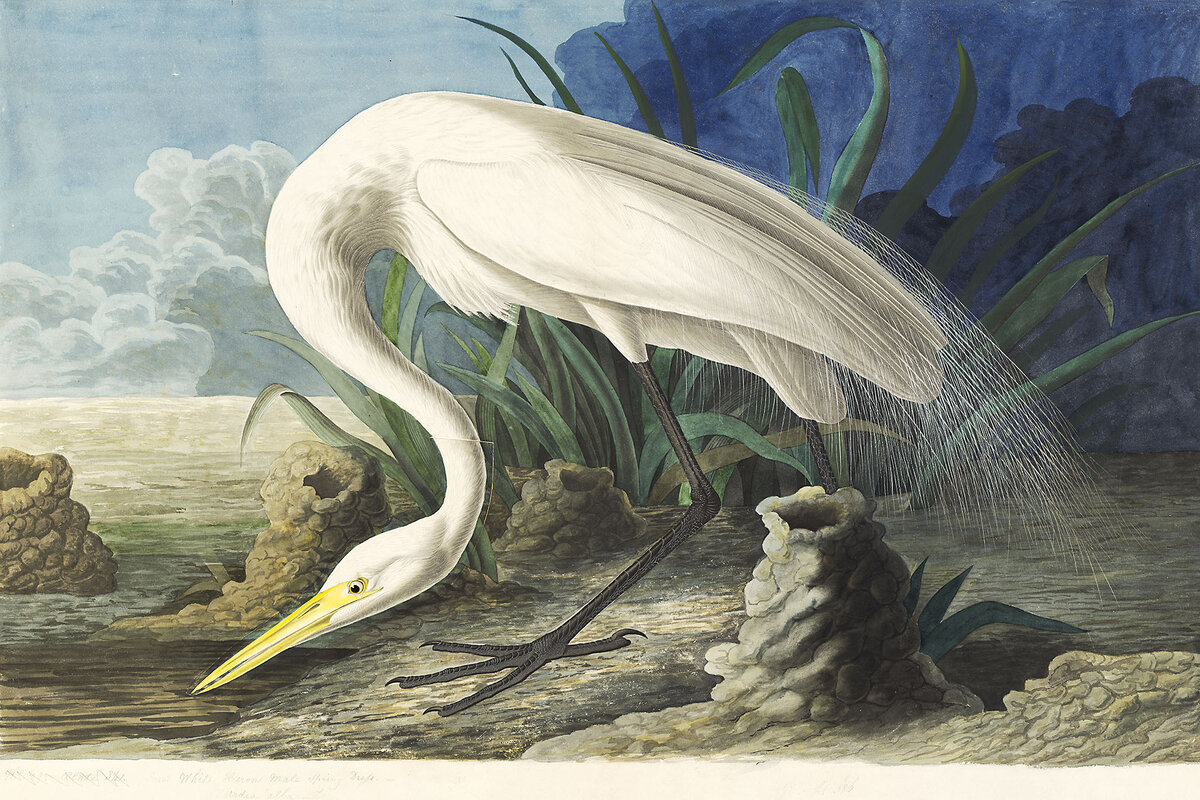
- Quick Read
- Deep Read ( 4 Min. )
-
By Danny Heitman Contributor
John James Audubon was more than a 19th-century self-taught ornithologist with a plan to depict bird species across America.
In “Audubon as Artist: A New Look at ‘The Birds of America,’” author Roberta J.M. Olson argues that Audubon’s lively and lifelike bird paintings drew their inspiration from classical European artists.
“He felt comfortable invoking Raphael, Titian, Rembrandt or Van Dyck in his writings and in his watercolor models for ‘The Birds,’” Olson writes.
Audubon’s career culminated in the publication of the four-volume “Birds of America” published between 1827 and 1838.
He was a dramatist at heart, and an abiding quality of his bird paintings is their vivid sense of theater. Even in pastoral scenes like his study of two magnolia warblers, the little birds vibrate with expectancy, each obviously poised for flight.
Nature for Audubon always had this kinetic quality; for him, movement was an essential proof of life.
Keeping up with America’s vast array of ornithological wonders has always been a group effort, and even the audacious Audubon couldn’t do it alone. “Audubon as Artist” is a timely reminder of his debt to many others.
Audubon’s bird paintings owe debt to classical European art
When John James Audubon immigrated to the United States from France in 1803, his timing was fortuitous. That same year, the Louisiana Purchase doubled the size of U.S. territory, deepening national curiosity about what lay in the vastness.
Audubon (1785-1851) answered that interest with “The Birds of America,” a mammoth pictorial survey of ornithological wildlife from the continent. People back in Europe were also intrigued, and Audubon capitalized on the endeavor’s broader appeal.
His project, which included 435 prints based on his watercolor paintings, depended partly on wealthy patrons across the Atlantic who were willing to buy the costly volumes of his “Birds of America” series, too. He also drew on the technical skill of printer Robert Havell Jr. in London to make the prints we now consider masterpieces.
In “Audubon as Artist: A New Look at ‘The Birds of America,’” Roberta J.M. Olson argues that Audubon drew more from Europe than financial and technical support. He also gained inspiration from European artists such as Jacques-Louis David.
“He felt comfortable invoking Raphael, Titian, Rembrandt or Van Dyck in his writings and in his watercolor models for ‘The Birds,’” Olson adds. Audubon’s career culminated in the publication of the four-volume “Birds of America” between 1827 and 1838.

Much has been written about Audubon and his work, but no one has charted his possible artistic influences as thoroughly as Olson, who has studied his art as a curator at the New-York Historical Society, where Audubon’s “Birds of America” watercolors are housed.
One likely reason that Audubon’s relationship with other artists has been neglected is that he’s been so celebrated for his singularity. In rejecting the static conventions of 19th-century bird art to create wildlife scenes that are pageants of motion, Audubon seemed more intent on breaking tradition than extending it.
Even so, Olson sees parallels between Audubon and previous masters, and her book includes many color reproductions of their work near his masterpieces so that readers can draw their own conclusions.
One such picture is “Death of Socrates,” David’s 1787 oil on canvas in which the heroic philosopher, his finger raised in a bold gesture of instruction, bids farewell to his students, a teacher to the finish. From David, says Olson, Audubon would have learned the ideal of tightly controlled compositions in the foreground, a key principle of his bird art.
Like David, Audubon was a dramatist at heart, and an abiding quality of his bird paintings is their vivid sense of theater. Even in ostensibly pastoral scenes like his study of two magnolia warblers, the little birds vibrate with expectancy, each obviously poised for flight as they perch on a blooming raspberry bush. Nature for Audubon always had this kinetic quality; for him, movement was an essential proof of life.
“Audubon as Artist” has arrived at a time when Audubon’s life and legacy face fresh scrutiny. He bought and sold enslaved people, and his racial views reflected those of many Americans of European descent in the 19th century. Critics wonder how a man whose bird pictures stood as emblems of freedom could embrace the bondage of other human beings. Our experience of his work today is further shaped by the knowledge that many of the bird species he painted were displaced by settlers who also drove out Indigenous people.

Olson tells readers early in “Audubon as Artist” that his social views and practices are best addressed in depth beyond her book – ideally within “a detailed biography that does not judge its subject solely by current values but takes into account those of his time.”
Audubon’s beliefs, which were widely shared by his contemporaries, can appear all the more surprising to us because in so many other respects, he seemed thoroughly modern. His deeply candid journals sometimes read like recent confessional memoirs, and this gripping sense of intimacy touches his pictures, too.
In carefully editing nature to create arresting narratives, Audubon deftly anticipated the kind of storytelling we’ve come to expect from nature documentaries. Crammed like a biblical ark with creaturely wonders, “The Birds of America” conveys a sense of summation, although its chronicle of American bird life is far from complete. (“The Birds That Audubon Missed,” a new book by Kenn Kaufman, underlines that reality.)
Keeping up with America’s vast array of ornithological wonders has always been a group effort, and even the audacious Audubon couldn’t do it alone. “Audubon as Artist” is a timely reminder of his debt to many others.
Other headline stories we’re watching
(Get live updates throughout the day.)The Monitor's View
Civic joy in South Africa’s vote
- Quick Read
- Deep Read ( 2 Min. )
-
By the Monitor's Editorial Board
Thirty years after South Africa ended its violent system of racial segregation called apartheid through peaceful elections, it may be poised for another watershed moment: a transition from one-party rule to pluralism and power-sharing.
For the first time in three decades, the ruling African National Congress may lose its majority in elections later this month. Voters are deeply frustrated by persistently high levels of corruption, crime, inequality, and unemployment. Discontentment, however, has not led to disengagement. Just the opposite. The May 29 election will include 31 new political parties. More than half of the nearly 15,000 candidates for local and national office are under the age of 50.
Casting their gaze forward, South Africans are shaping a future – for themselves and their continent – unfettered by a limiting past.
Civic joy in South Africa’s vote

Thirty years after South Africa ended its violent system of racial segregation called apartheid through peaceful elections, it may be poised for another watershed moment: a transition from one-party rule to pluralism and power-sharing.
For the first time in three decades, the ruling African National Congress (ANC) may lose its majority in elections later this month. Voters are deeply frustrated by persistently high levels of corruption, crime, inequality, and unemployment. Just 16% of South Africans ages 18 to 24 express optimism about the future, according to a survey released this week by the Ichikowitz Family Foundation.
Discontentment, however, has not led to disengagement. Just the opposite. According to the Electoral Commission of South Africa, the May 29 election will include 31 new political parties. More than half of the nearly 15,000 candidates for local and national office are under the age of 50. Four in 10 are female. Fifteen candidates have only just reached the minimum voter age of 18.
That civic enthusiasm underscores how democracy is maturing, not just in South Africa but across the continent. Entrenched parties like the ANC tend to look backward, basing their claim to power on how they helped their societies break free of colonialism. But 60% of the continent’s population is under the age of 25. Younger Africans are forward-looking, innovative, and impatient.
“A young nation like ours is no place to advocate for quiet, sterile democracy,” wrote a South African data scientist Wednesday in American Purpose, using a pseudonym. “Now the Rainbow Nation is growing up to become ... loud, rambunctious, and argumentative” – driving a shift in importance from political parties to “the individual uniters rising up within each party.”
One candidate for the governor of KwaZulu-Natal province, Chris Pappas of the Democratic Alliance, sees younger people looking to the future. “My generation, we acknowledge the legacy of apartheid, its challenges and inequality, but we also can’t live there permanently,” he told the Sunday Times.
Jaco Kruger, academic dean of St. Augustine College of South Africa, sees as a change in the way Africans are defining their concepts of nationhood – from material factors like ethnicity to “an intangible reality that exists in the minds and the hearts of a large and diverse body of people.”
“Nationhood remains an open question and a task for citizens’ imagination,” he wrote Thursday in the Mail and Guardian newspaper. Through storytelling, dialogue, and listening, leaders and citizens learn to “see possibilities for connecting the dots in a different way so that a better story may be told and better conditions for living together may open up.”
Casting their gaze forward, South Africans are shaping a future – for themselves and their continent – unfettered by a limiting past.

A Christian Science Perspective
Each weekday, the Monitor includes one clearly labeled religious article offering spiritual insight on contemporary issues, including the news. The publication – in its various forms – is produced for anyone who cares about the progress of the human endeavor around the world and seeks news reported with compassion, intelligence, and an essentially constructive lens. For many, that caring has religious roots. For many, it does not. The Monitor has always embraced both audiences. The Monitor is owned by a church – The First Church of Christ, Scientist, in Boston – whose founder was concerned with both the state of the world and the quality of available news.
The divine economy in unstable times
- Quick Read
- Read or Listen ( 4 Min. )
-
By David Hohle
We really are the children of God, cared for and loved, and we experience this more tangibly as we lean on the Divine as the stable, reliable source of goodness.
The divine economy in unstable times
Good seems to be tied to human effort. We work hard to “earn a living” – earn an income, which in turn enables us to buy what we need to live. So it seems that through our own efforts good things flow into our lives.
But this logic has a troubling flip side: If something changes humanly, the flow of good can appear to be interrupted, even stopped.
Christian Science opens the door to a different view, a view of a spiritual economy made up of an infinite source and ceaseless distribution of constant divine goodness – continuous, uninterrupted, and independent of human factors. In this divine economy, good flows directly and unhindered from God to His idea, man, which includes each of us in our true relation to God, our spiritual identity. Christ Jesus described it this way: “Behold the fowls of the air: for they sow not, neither do they reap ... ; yet your heavenly Father feedeth them. Are ye not much better than they?” (Matthew 6:26).
Man, being completely spiritual, has an unbroken connection to this pure, constant flow of good from divine Spirit. Human economic conditions don’t affect it. And this infinite impartation of good from God is equal to every demand that will ever be made on it. A sentence from the Christian Science textbook, “Science and Health with Key to the Scriptures” by Mary Baker Eddy, captures this: “Divine Love always has met and always will meet every human need” (p. 494).
As our fledgling trust in God grows through humble prayer, we glimpse more of our spiritual nature and the far-reaching yet practical effects of the divine economy. The Bible is filled with examples of this.
Take, for instance, the Exodus of the children of Israel from Egypt written about in the Old Testament. As they left what they were familiar with and ventured forward following Moses, they did so hesitatingly because freedom meant the end of whatever meager material supports slavery had provided. They needed to learn how to trust in God’s care for them. They wondered, “Can God furnish a table in the wilderness?” (Psalms 78:19).
The answer to this question rolled out continuously over 40 years as they journeyed through the wilderness to the Promised Land. Their food was provided in the unprecedented form of daily manna and quail. When they were parched in the desert, they prayed to God, and water gushed from a rock; more than enough water was provided for them – and for their animals, too. Even their clothes and shoes didn’t wear out. God provided an ongoing table in the wilderness then – and God continues to do so now.
A friend of mine was once in desperate need of water. He and a companion had walked for days and had become so exhausted that they actually parted ways, determined to crawl off in different directions to die.
At this point my friend prayed, “God, show me where the water is.” This was a simple, brief, direct prayer to an intelligent, loving, ever-present Father-Mother God. He prayed with a full faith that God would give him what he needed.
He then noticed an opening in the ground like a shaft. Easing himself into the darkness, he managed to climb down. At the bottom he found water. A few minutes later he climbed out and tracked down his friend. His simple appeal to the great heart of Love preserved them both after days of human effort had failed.
Today, our world seems to be shifting in ways we’ve never seen. For many, frustration and fear may crowd out peace and confidence. Can the average individual and family enjoy the benefits of the divine economy today? Yes.
For starters, we can stop thinking of ourselves as separate from God and therefore required to work things out without God’s help. Rather, we can affirm that we are actually spiritual ideas with a vital, unbroken connection to Spirit, the source of all good. The answer we need is necessarily a spiritual answer.
God, Spirit, is always present, caring for us precisely, perfectly, without fail and without interruption. This is why we can claim that divine Love really always has met every human need, and always will, and that our particular need is not outside this efficient divine economy. Such truths, when understood, make room for the power of God to operate in our lives.
The ever-operating divine economy is available to each of us.
Adapted from an editorial published in the Nov. 9, 2020, issue of the Christian Science Sentinel.

Viewfinder
Lighting the way

A look ahead
Thanks for reading the Daily today. Tomorrow, Asia Editor Lindsey McGinnis guest hosts an episode of our “Why We Wrote This” podcast. She’s joined by correspondent Fahad Shah for a conversation about the logistics of covering India’s ongoing elections – and doing so through the lens of trust.




